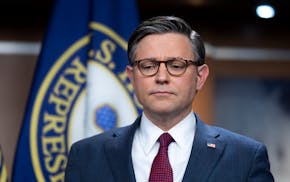Amid the worst unemployment numbers in years and a deteriorating economic outlook, Minnesota got a whiff of good news on Thursday -- indications that the federal stimulus package being shaped in Washington could send as much as $3.2 billion this way.
That's far more than anything state leaders had imagined and could go a long way toward taking the sting out of the state's $4.8 billion projected deficit.
How much is $3.2 billion?
It's equal to roughly 10 percent of the state's entire budget -- enough to pay for everything the state spends on public safety, prisons, environment, energy, agriculture, veterans, job development, all state agencies, transportation and natural resources.
For two years. "The numbers could still change," House Speaker Margaret Anderson Kelliher, DFL-Minneapolis, said Thursday while traveling in Washington. "But this is potentially very good news for the state."
The $3.2 billion figure comes from a National Conference of State Legislatures (NCSL) estimation of state allocations based on the bill moving through the U.S. House Appropriations Committee. Kelliher has been in Washington this week to attend the presidential inauguration and meet with the state's congressional delegation on the economic crisis.
Minnesota's economic straits are such that even a $3 billion aid package would only cushion what is expected to be a hard landing when the next round of revenue projections comes out in early March.
The state's projected deficit for 2010-11 was $4.8 billion as of November, but the economy has spiraled downward since then, and many anticipate that the shortfall could reach $6 billion -- or nearly 20 percent of the state's total two-year revenues.
New labor figures on Thursday showed that the state is approaching 7 percent unemployment, with job losses in nearly every sector, particularly among white-collar professionals in the metro area.
Gov. Tim Pawlenty said the fiscal stimulus will be welcome but that the short-term outlook remains grim.
"We're in economic collapse," Pawlenty said. "The job numbers have been terrible for a while and will continue to be terrible until the economy begins to turn around."
The economy's "free fall," he said, "makes it all the more important to take steps in this session and beyond to position Minnesota for job growth and to be more competitive."
Kelliher said that while more work needs to be done on divvying up what could be a trillion-dollar federal spending plan, Minnesota's share appears to be sizable.
"This is not speculation," she said. "This is enough that it could help us get through an extremely turbulent time and, if it holds up, could get us on the path to stabilize the state budget." Pawlenty readies budget
Pawlenty, who will present his two-year budget proposal on Tuesday, said during an informal preview with reporters that his plan will rely primarily on spending cuts and other accounting methods to eliminate the deficit.
Asked if there were any revenue-raisers -- either taxes or fees -- in the proposal, Pawlenty replied,
"No. We're able to balance the budget without them." Pawlenty spokesman Brian McClung said the budget does presume a sizable federal stimulus that eventually could be used to mitigate the effects of deep cuts in health care, higher education and local government aid that Pawlenty is expected to propose.
Kelliher said Thursday that the state should appoint a respected, neutral, elder statesman-type to act as point person for the billions that will come into Minnesota's diminished treasury.
The federal money, when it arrives, is expected to come with definite strings attached, detailed requirements for how it is spent and documentation that leaves a transparent trail. The estimate from the NCSL breaks the money down into numerous categories, including K-12 construction, child care, clean water, drinking water, Medicaid and even weatherization.
McClung said Pawlenty has been working on developing a "governor's federal stimulus coordinator" position but had not settled on an individual. Patricia Lopez • 651-222-1288
